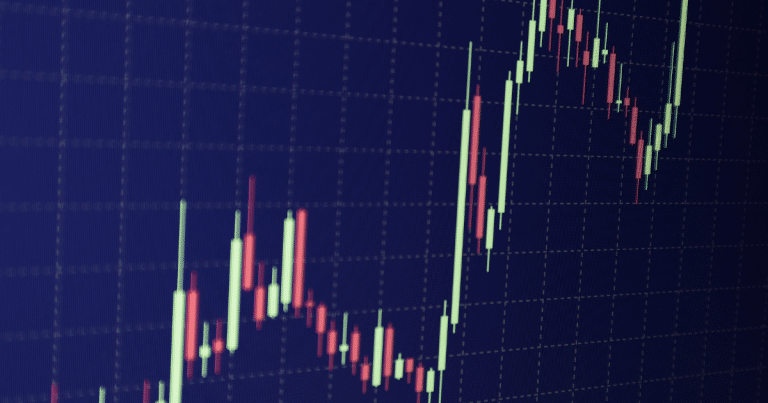
Understanding Moving Average Crossovers
Why Moving Average Crossovers Matter
When two moving average lines cross, traders get a heads-up on when to jump in or out of trades. It’s like a neon sign flashing “trend change ahead!” Picture this: a bullish crossover happens when a short-term moving average zips above a long-term one, hinting at an upward trend. On the flip side, a bearish crossover occurs when the short-term line dips below the long-term one, signaling a downward trend.
These crossovers are popular because they’re simple and they work. They give clear signals for when to buy or sell, which can be double-checked with chart patterns or support and resistance levels. The magic of these crossovers is in how they help traders make smart decisions based on the crossing of different moving averages.
How to Use Them in Trading
In trading, moving average crossovers are like a trusty compass, pointing out when to enter or exit the market. Traders watch the intersection of two moving averages to spot potential trades. This means comparing two moving averages of different lengths and waiting for one to cross above or below the other.
This strategy is great for spotting trend momentum and possible market reversals. By watching the crossover, traders get a feel for the market’s direction and the trend’s strength. A classic example is using the 50-day and 200-day moving averages. When the 50-day crosses above the 200-day, it’s a bullish signal, suggesting it’s time to buy. When the 50-day crosses below the 200-day, it’s a bearish signal, suggesting it’s time to sell.
| Crossover Type | Signal |
|---|---|
| Bullish Crossover | Buy |
| Bearish Crossover | Sell |
These strategies are easy to use, even for beginners. But, they do have their quirks. They might not react quickly to sudden market changes and can give false signals in a choppy market. So, it’s smart to pair moving average crossovers with other indicators and analysis methods to make your trading signals more reliable.
For more tips on different moving average types, check out our article on moving average types. Plus, understanding the differences between simple moving average vs exponential moving average can fine-tune your trading game.
The Exponential Moving Average (EMA)
The Exponential Moving Average (EMA) is a handy tool for traders to smooth out price data and spot trends faster than other moving averages. Let’s break down how the EMA stacks up against the Simple Moving Average (SMA), and how you can calculate and use it.
EMA vs. SMA: What’s the Difference?
The EMA gives more weight to recent data points, making it quicker to react to price changes than the SMA (Investopedia). This makes the EMA better for catching short-term price movements.
| Moving Average Type | Weighting of Recent Data |
|---|---|
| Simple Moving Average (SMA) | Equal weight to all data points |
| Exponential Moving Average (EMA) | More weight to recent data points |
For example, a 10-day EMA gives an 18.18% weight to the latest price, while a 20-day EMA only gives it 9.52% (Investopedia).
How to Calculate and Read the EMA
To calculate the EMA, you need a multiplier to smooth out the data. Here’s the formula:
Multiplier = 2 Number of observations + 1Once you have the multiplier, follow these steps:
- Calculate the SMA for the initial EMA value over your chosen period.
- Apply the multiplier to the most recent price.
- Add the result to the previous EMA value, adjusting for the weighting.
Let’s say you want to calculate a 10-day EMA with a recent closing price of $50. Here’s how you’d do it:
10-day EMA Multiplier = 2 10 + 1 = 0.1818Current EMA = ( Current Price – Previous EMA ) × Multiplier + Previous EMA
If the previous EMA was $48:
Current EMA = ( 50 – 48 ) × 0.1818 + 48 = 48.36The EMA helps traders see the direction and strength of a trend. By comparing EMA values over different periods, you can spot potential buy and sell signals. A popular strategy is the crossover method, where a short-term EMA crosses above or below a long-term EMA, signaling potential market entry or exit points (Investopedia).
For more on different moving averages and their comparisons, check out our article on simple moving average vs exponential moving average.
Using EMAs in your trading strategy can help you spot trends and make smarter trading decisions. Understanding how to calculate and interpret the EMA is the first step to using it effectively. For tips on choosing the right timeframes for EMAs, see our guide on time frame selection.
Making the Most of EMAs in Trading
Exponential Moving Averages (EMAs) are like the Swiss Army knife for traders. They help you spot market trends and generate trading signals. Let’s break down how to pick the right EMA timeframes and mix EMAs with other indicators to boost your trading game.
Picking the Right EMA Timeframe
Choosing the right EMA timeframe is like picking the right tool for the job. It all depends on your trading style and goals.
Short-Term Traders: If you’re into day trading or scalp trading, go for shorter EMAs like the 9-day or 12-day EMA. These EMAs react fast to price changes, giving you quick signals to jump in or out of trades.
Medium-Term Traders: Swing traders usually go for medium-term EMAs like the 20-day or 50-day EMA. These EMAs strike a balance between being responsive and stable, helping you spot potential swing points in the bigger trend.
Long-Term Traders: If you’re more of an investor or position trader, long-term EMAs like the 100-day or 200-day EMA are your best bet. They smooth out the short-term noise, giving you a clearer view of the overall market trend.
| Trading Style | Timeframe (Days) | Responsiveness |
|---|---|---|
| Short-Term | 9, 12 | High |
| Medium-Term | 20, 50 | Moderate |
| Long-Term | 100, 200 | Low |
Don’t forget to consider the specific market you’re trading in. For more tips, check out our detailed guide on time frame selection.
Mixing EMAs with Other Indicators
EMAs are great on their own, but they really shine when you pair them with other indicators. Here are some popular combos:
EMA and RSI (Relative Strength Index): The RSI measures how fast and how much prices are moving, giving you a heads-up on overbought or oversold conditions. When your EMA shows a trend and the RSI backs it up, you can trade with more confidence.
EMA and MACD (Moving Average Convergence Divergence): The MACD is a momentum indicator that shows the relationship between two EMAs (usually the 12-day and 26-day EMAs). When the MACD line crosses above the signal line, it’s a bullish signal, and vice versa for bearish signals. Pairing this with an EMA can give you solid entry and exit points. Learn more about MACD in our article on moving average convergence divergence.
EMA and Volume: Volume indicators like the Volume Weighted Average Price (VWAP) can validate the strength of price moves. For example, a price crossing above an EMA on high volume is a stronger signal than the same move on low volume.
By combining EMAs with other indicators, you can create more well-rounded trading strategies. For more ideas, check out our section on moving average trading strategies.
Using the exponential moving average crossover strategy effectively means knowing how to pick the right timeframes and pair EMAs with other indicators. This not only makes your trading signals more accurate but also helps you make smarter trading decisions. For more on EMAs, visit our article on the exponential moving average.
Trading Strategies with EMAs
Using the Exponential Moving Average (EMA) in trading can really step up your game. Let’s break down two main strategies: EMA crossover signals and moving average ribbons.
EMA Crossover Signals
EMA crossover signals are a go-to for many traders. They use two or more EMAs to spot potential buy and sell signals. This involves watching where two EMAs of different lengths intersect to catch trend changes (TrendSpider).
Double EMA Crossover Strategy
This strategy uses two EMAs: a short-term EMA and a long-term EMA. When the short-term EMA crosses above the long-term EMA, it’s a bullish signal, hinting at an uptrend. If the short-term EMA crosses below the long-term EMA, it’s a bearish signal, suggesting a downtrend.
| Signal | Short-term EMA | Long-term EMA | Action |
|---|---|---|---|
| Bullish | Above | Below | Buy |
| Bearish | Below | Above | Sell |
Price Crossover Strategy
Here, you look for crossovers between the price and an EMA. If the price crosses above the EMA, it’s a bullish signal for a potential uptrend. If it crosses below, it’s a bearish signal for a potential downtrend.
| Signal | Price | EMA | Action |
|---|---|---|---|
| Bullish | Above | Below | Buy |
| Bearish | Below | Above | Sell |
Want more on different types of moving averages? Check out our article on moving average types.
Moving Average Ribbons
Moving average ribbons use multiple EMAs to give a clearer picture of market trends. This involves plotting several EMAs of different timeframes on one chart, creating a “ribbon” effect. This visual can help traders see the strength and direction of a trend.
Interpreting Moving Average Ribbons
- Convergence: When EMAs are close together, it shows low volatility and possible consolidation.
- Divergence: When EMAs spread apart, it signals increasing volatility and a strong trend.
| EMA Periods | Interpretation |
|---|---|
| Close together | Low volatility |
| Spread apart | High volatility |
Practical Application
Traders can use moving average ribbons to confirm trend direction and strength. If all the EMAs are aligned and moving up, it suggests a strong uptrend. If they’re aligned and moving down, it indicates a strong downtrend.
Combining EMA strategies with other indicators like the moving average convergence divergence (MACD) can boost your trading decisions. For more on picking the right timeframes for your EMAs, see our article on time frame selection.
By using EMA crossover signals and moving average ribbons, traders can better spot trends and make smarter trading decisions. For more detailed strategies, visit our page on moving average trading strategies.
Using EMA in Forex Trading
The exponential moving average (EMA) is a handy tool in forex trading, often forming the backbone of many trading strategies. Let’s dive into how EMA strategies are used in forex trading and why EMA crossover signals matter.
EMA Strategies in Forex
Traders love the EMA for spotting trends and potential trades. Unlike the simple moving average (SMA), the EMA gives more weight to recent prices, making it quicker to react to price changes. This quick response is a lifesaver in the fast-moving forex market.
Popular EMAs in forex trading include 5, 10, 12, 20, 26, 50, 100, and 200 periods (Investopedia). Shorter-term EMAs like 5 and 10 are great for short-term charts, while longer-term EMAs like 20 and 50 are better for higher timeframes.
| EMA Period | Common Use |
|---|---|
| 5 | Short-term trading |
| 10 | Short-term trading |
| 12 | Mid-term trading |
| 20 | Mid-term trading |
| 26 | Mid-term trading |
| 50 | Long-term trading |
| 100 | Long-term trading |
| 200 | Long-term trading |
Your choice of EMA periods depends on your strategy and goals. Many traders mix short-term and long-term EMAs to spot trends and make smart decisions.
EMA Crossover Signals in Forex
One popular strategy is the EMA crossover. This involves two EMAs: a short-term EMA and a long-term EMA. When the short-term EMA crosses above the long-term EMA, it’s a buy signal, hinting at an uptrend. When the short-term EMA crosses below the long-term EMA, it’s a sell signal, suggesting a downtrend (Investopedia).
| Crossover Type | Signal |
|---|---|
| Short-term EMA crosses above Long-term EMA | Buy |
| Short-term EMA crosses below Long-term EMA | Sell |
A common combo in forex trading is the 50 EMA with the 10 or 20 EMA. For instance, if the 10 EMA crosses above the 50 EMA, it’s a buy signal. If the 10 EMA crosses below the 50 EMA, it’s a sell signal.
To make the EMA crossover strategy even better, traders often pair it with other indicators like the moving average convergence divergence (MACD) or the volume weighted average price (VWAP). This helps confirm signals and cut down on false positives.
By using EMA strategies and understanding EMA crossover signals, you can make smarter decisions in the forex market. For more on different moving average types and their uses, check out our article on moving average trading strategies.








this is super helpful for a beginner like me! i’m finally starting to get the hang of moving averages, and this breakdown really helped. thanks!
I’m not sure if I’m convinced about the usefulness of moving average crossovers. I’ve used them before and haven’t seen any significant results. But maybe it’s just me, maybe I’m not using them correctly.
Interesting take on EMA vs SMA Ive always used SMA but maybe Ill give EMA a try Im curious to see how it performs I might even try backtesting it on some of my favorite stocks
Great info, thanks! This clarified a lot of things for me. Moving average crossovers, EMA, SMA, got it. It’s all coming together now
This is awesome! I’ve been trying to learn about moving averages for a while now and your explanation is the best I’ve seen. I’m definitely bookmarking this article!